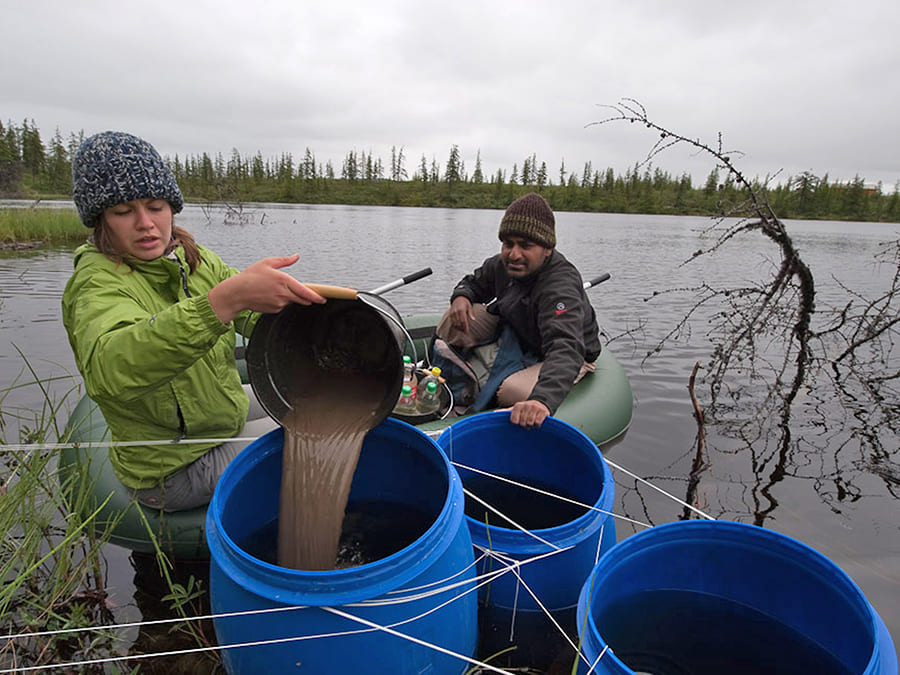Ancient carbon from Pleistocene era animals, along with chunks of green grass growing in the ancient soil, is being flushed into Arctic lakes and rivers as the long-frozen permafrost thaws, producing methane gas and possibly carbon dioxide that may be causing further global warming.
To study this climate change phenomena, Sudeep Chandra, University of Nevada, Reno faculty member and researcher will be returning for his second year as one of the principal investigators with the Polaris Project, an international team of scientists and students studying climate change in the Siberian Arctic.
Joanne Heslop, an undergraduate at the University, was one of the few students across the country chosen in the highly competitive selection process to participate. It will be her first year in the month-long program. They left July 2 for the research and field course.
“Very few people, let alone Russians or Americans, have visited this remote location and it is a spectacular and challenging environment to experience,” Chandra said. “I am sure Joanne will come back with new insights on life and directions that will be immeasurable, and can be shared with her peers and our community."
The Polaris Project program is training future leaders in Arctic research and education, and informing the public about the impacts of climate change, essential goals given the rapid and profound transformations underway in the Arctic.
"The Polaris project is an exciting and innovative approach to engage young scientists, professors and students to think about careers in climate research,” Chandra said. “The goal is to bring them to the most complicated parts of the world that are responding to increased temperature, where they can see the impacts and bring creative ideas on how to tackle the issues related to climate change.”
Chandra said the project also encourages the participants to spread the word about how climate impacts almost every facet of our society today.
“The Arctic is central to the global climate change issue, and Russia has by far the largest share of the Arctic. Yet few Western scientists, much less students, ever get the chance to work in the Siberian Arctic,” said R. Max Holmes, an associate scientist at the Woods Hole Research Center and director of the Polaris Project. “This research experience is a unique collaboration among students, educators, and scientists from distinct cultures working together to address a critically important scientific challenge.”
This is the second year of the Polaris Project field course. Undergraduate researchers and team members will work across five different ecosystem types at a field station in remote northeastern Russia, including estuary/ocean, forest/tundra, stream/rivers, lakes and riparian/floodplain areas. The students and scientists will study the transport and transformations of carbon and nutrients as they move with water from terrestrial uplands to the Arctic Ocean. In particular, they will look at the linkages among the different ecosystems and how processes occurring in one component influence the others.
While in Siberia, the students and scientists will be based at the Northeast Science Station located approximately 80 kilometers south of the Arctic Ocean in northeastern Russia on the Kolyma River, near Cherskiy. The participants will stay on a 90-foot long barge that will serve as a mobile base for field trips up and down the river. For a graphic of the location and for photos from 2008 go to The Polaris Project.
In addition to the field course, the Polaris Project includes research experience for undergraduate students in the Siberian Arctic, several new Arctic-focused undergraduate courses taught by project co-primary investigators at their home institutions, the opportunity for those scientists to initiate research programs in the Siberian Arctic, and a wide range of outreach activities. All project participants, both students and faculty, will visit kindergarten through grade 12 classrooms in their home cities to convey the excitement of polar research.
Chandra has incorporated climate change issues in his Natural Resources and Environmental class taught in the fall semester: Conservation, Humans, and Biodiversity (NRES 211).
“We spend a lot of time discussing the issues and realities of climate change and how scientists agree and disagree based on scientific studies on the extent of change in the future,” he said. “Students are required to take this class before then can apply to be part of the Polaris Project.”
The Polaris Project is a collaborative effort by the Woods Hole Research Center, seven universities and colleges, and the Northeast Science Station in Cherskiy, Russia. The project is generously supported by the National Science Foundation's International Polar Year Program.
Along with the University of Nevada, Reno, other institutions involved with the project are: Carleton College, Minn.; Clark University, Mass.; St. Olaf College, Minn.; Western Washington University, Wash.; Yakutsk State University, Russia; Holy Cross College, Mass.; University of Alaska, Fairbanks and Woods Hole Research Center, Mass.
“Programs like this one make me very hopeful that scientists and students from different countries will be able to bring much needed information to the public’s attention,” Chandra said. “I can’t wait to share our findings when we return in a month.”
















